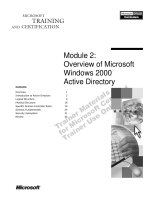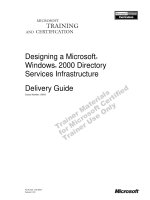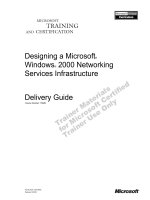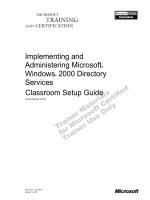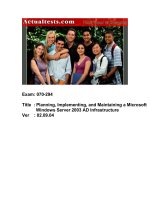Designing a Microsoft® Windows® 2000 Directory Services Infrastructure
Bạn đang xem bản rút gọn của tài liệu. Xem và tải ngay bản đầy đủ của tài liệu tại đây (4.64 MB, 320 trang )
Part Number: X05-39393
Course Number: 1561B
Released: 2/00
Delivery Guide
Designing a Microsoft
®
Windows
®
2000 Directory
Services Infrastructure
Information in this document is subject to change without notice. The names of companies,
products, people, characters, and/or data mentioned herein are fictitious and are in no way intended
to represent any real individual, company, product, or event, unless otherwise noted. Complying
with all applicable copyright laws is the responsibility of the user. No part of this document may
be reproduced or transmitted in any form or by any means, electronic or mechanical, for any
purpose, without the express written permission of Microsoft Corporation. If, however, your only
means of access is electronic, permission to print one copy is hereby granted.
Microsoft may have patents, patent applications, trademarks, copyrights, or other intellectual
property rights covering subject matter in this document. Except as expressly provided in any
written license agreement from Microsoft, the furnishing of this document does not give you any
license to these patents, trademarks, copyrights, or other intellectual property.
2000 Microsoft Corporation. All rights reserved.
Microsoft, Windows, Windows NT, Active Directory, BackOffice, PowerPoint, Visual Basic, and
Visual Studio are either registered trademarks or trademarks of Microsoft Corporation in the
U.S.A. and/or other countries.
The names of companies, products, people, characters, and/or data mentioned herein are fictitious
and are in no way intended to represent any real individual, company, product, or event, unless
otherwise noted.
Other product and company names mentioned herein may be the trademarks of their respective
owners.
Project Lead:
Andy Sweet (S&T OnSite)
Instructional Designers:
Andy Sweet (S&T OnSite), Ravi Acharya (NIIT), Sid Benavente,
Richard Rose, Kathleen Norton
Instructional Design Consultants:
Paul Howard, Susan Greenberg
Program Managers:
Lorrin Smith-Bates (Volt), Megan Camp (Independent Contractor)
Technical Contributors:
Angie Fultz, Lyle Curry, Brian Komar (3947018 Manitoba, Inc.), Jim
Clark (Infotec Commercial Systems), Bill Wade (Excell Data Corporation), David Stern, Steve
Tate, Greg Bulette (Independent Contractor), Kathleen Cole (S&T OnSite)
Graphic Artist:
Kirsten Larson (S&T OnSite)
Editing Manager:
Lynette Skinner
Editor:
Jeffrey Gilbert (Wasser)
Copy Editor:
Patti Neff (S&T Consulting)
Online Program Manager:
Debbi Conger
Online Publications Manager:
Arlo Emerson (Aditi)
Online Support:
Eric Brandt (S&T Consulting)
Multimedia Development:
Kelly Renner (Entex)
Testing Leads:
Sid Benavente, Keith Cotton
Testing Developer:
Greg Stemp (S&T OnSite)
Compact Disc and Lab Testing:
Testing Testing 123
Production Support:
Ed Casper (S&T Consulting)
Manufacturing Manager:
Rick Terek (S&T OnSite)
Manufacturing Support:
Laura King (S&T OnSite)
Lead Product Manager, Development Services:
Bo Galford
Lead Product Managers:
Dean Murray, Ken Rosen
Group Product Manager:
Robert Stewart
Course Number: 1561B
Part Number: X05-39393
Released: 2/00
# 'HVLJQLQJ#D#0LFURVRIWŠ#:LQGRZVŠ#5333#'LUHFWRU\#6HUYLFHV#,QIUDVWUXFWXUH##LLL#
&RQWHQWV##
,QWURGXFWLRQ
Course Materials......................................................................................................2
Prerequisites.............................................................................................................3
Course Outline.........................................................................................................4
Microsoft Official Curriculum.................................................................................6
Microsoft Certified Professional Program...............................................................7
Facilities...................................................................................................................9
0RGXOH#4=#,QWURGXFWLRQ#WR#'HVLJQLQJ#D#'LUHFWRU\#6HUYLFHV#,QIUDVWUXFWXUH
Overview..................................................................................................................1
Role of Active Directory in an Enterprise................................................................2
Conducting an Organizational Analysis ..................................................................3
Architectural Elements of Active Directory ............................................................7
Review...................................................................................................................15
0RGXOH#5=#'HVLJQLQJ#DQ#$FWLYH#'LUHFWRU\#1DPLQJ#6WUDWHJ\
Overview..................................................................................................................1
Identifying Business Needs......................................................................................2
DNS and Active Directory.......................................................................................3
Planning Active Directory Domain Names .............................................................7
Designing a DNS Naming Strategy for Active Directory......................................11
Lab A: Designing an Active Directory Naming Strategy ......................................22
Review...................................................................................................................31
0RGXOH#6=#'HVLJQLQJ#$FWLYH#'LUHFWRU\#WR#'HOHJDWH#$GPLQLVWUDWLYH#
$XWKRULW\
Overview..................................................................................................................1
Identifying Business Needs......................................................................................2
Characterizing the IT Organization..........................................................................4
Developing a Strategy for Administrative Design...................................................5
Developing a Strategy for Delegation....................................................................15
Lab A: Designing Delegated Administration.........................................................24
Review...................................................................................................................35
0RGXOH#7=#'HVLJQLQJ#D#6FKHPD#3ROLF\
Overview..................................................................................................................1
Identifying Business Needs......................................................................................2
Schema Fundamentals .............................................................................................3
Implications of Modifying the Schema....................................................................9
Planning for Schema Modification ........................................................................11
Lab A: Modifying the Schema...............................................................................20
Review...................................................................................................................27
LY##'HVLJQLQJ#D#0LFURVRIWŠ#:LQGRZVŠ#5333#'LUHFWRU\#6HUYLFHV#,QIUDVWUXFWXUH#
0RGXOH#8=#'HVLJQLQJ#$FWLYH#'LUHFWRU\#WR#6XSSRUW#*URXS#3ROLF\
Overview................................................................................................................. 1
Identifying Business Needs..................................................................................... 2
Applying Group Policy in Active Directory........................................................... 4
Planning for Group Policy .................................................................................... 10
Lab A: Designing Group Policy and a Supporting Active Directory Structure.... 21
Review .................................................................................................................. 32
0RGXOH#9=#'HVLJQLQJ#DQ#$FWLYH#'LUHFWRU\#'RPDLQ
Overview................................................................................................................. 1
Identifying Business Needs..................................................................................... 2
Designing the Initial Active Directory Domain...................................................... 3
Planning for Security Groups.................................................................................. 4
Discussion: Designing Security Groups.................................................................. 9
Planning for OUs .................................................................................................. 11
Lab A: Designing a Group and Organizational Unit Strategy .............................. 15
Review .................................................................................................................. 22
0RGXOH#:=#'HVLJQLQJ#D#0XOWLSOH0'RPDLQ#6WUXFWXUH
Overview................................................................................................................. 1
Identifying Business Needs..................................................................................... 2
Accessing Resources Between Domains ................................................................ 5
Planning for Multiple-Domain Trees...................................................................... 9
Planning for Multiple-Tree Forests....................................................................... 13
Planning for Multiple Forests ............................................................................... 16
Lab A: Designing a Multiple-Domain Structure................................................... 19
Review .................................................................................................................. 23
0RGXOH#;=#'HVLJQLQJ#DQ#$FWLYH#'LUHFWRU\#6LWH#7RSRORJ\
Overview................................................................................................................. 1
Using Sites in Active Directory.............................................................................. 2
Assessing the Need for Active Directory Sites....................................................... 5
Using Site Links in a Network................................................................................ 9
Planning the Inter-Site Replication Topology....................................................... 14
Planning for Server Placement in Sites................................................................. 19
Demonstration: Active Directory Sizer................................................................. 23
Lab A: Planning Sites to Control Active Directory Replication........................... 24
Review .................................................................................................................. 35
0RGXOH#<=#'HVLJQLQJ#DQ#$FWLYH#'LUHFWRU\#,QIUDVWUXFWXUH
Overview................................................................................................................. 1
Conducting an Organizational Analysis.................................................................. 2
Designing an Active Directory Structure.............................................................. 11
Creating a Functional Specification...................................................................... 20
Lab A: Designing an Active Directory Infrastructure........................................... 21
Review .................................................................................................................. 31
# 'HVLJQLQJ#D#0LFURVRIWŠ#:LQGRZVŠ#5333#'LUHFWRU\#6HUYLFHV#,QIUDVWUXFWXUH##Y#
$ERXW#7KLV#&RXUVH#
This section provides you with a brief description of the course, audience,
suggested prerequisites, and course objectives.
'HVFULSWLRQ#
This course provides students with the knowledge and skills necessary to design
a Microsoft
®
Windows
®
2000 directory services infrastructure in an enterprise
environment. After completion of this course, a student will be able to identify
the business and administrative needs of an organization that impact the design
of the Active Directory
™
directory service. The student will be able to describe
key decision points for naming, delegation of authority, domain design, and site
topology design. The student will then be able to translate the business needs of
an organization into an Active Directory design that meets those needs.
$XGLHQFH#
This course is intended for senior support professionals, architects, and
consultants responsible for developing an Active Directory design based on the
business needs of an organization. This course is also appropriate for those who
are on the Microsoft Certified Systems Engineer Windows 2000 track and wish
to acquire the skills necessary to design an Active Directory services
infrastructure.
6WXGHQW#3UHUHTXLVLWHV#
This course requires that students meet the following prerequisites:
•
Course 1560, Updating Support Skills from Microsoft Windows NT 4.0 to
Microsoft Windows 2000, or equivalent knowledge and skills.
OR
•
Course 2154, Implementing and Administering Microsoft Windows 2000
Directory Services, or equivalent knowledge and skills.
&RXUVH#2EMHFWLYHV#
At the end of this course, the student will be able to:
„#
Describe guidelines for gathering business and administrative information
from an organization and explain how an architect uses that information to
design an Active Directory for an enterprise.
„#
Design an Active Directory naming strategy that accommodates the
organizational structure of a business.
„#
Develop a plan to secure and delegate administrative authority over Active
Directory objects based on the administrative model of an organization.
„#
Identify business needs and scenarios that may require modification of the
Active Directory schema, and plan a policy to govern schema modification.
„#
Create an Active Directory design based on administrative Group Policy
requirements defined by business needs.
YL##'HVLJQLQJ#D#0LFURVRIWŠ#:LQGRZVŠ#5333#'LUHFWRU\#6HUYLFHV#,QIUDVWUXFWXUH#
„#
Design an Active Directory domain and the organizational unit hierarchy
within the domain.
„#
Identify situations where a multiple-domain Active Directory structure may
be necessary to meet the administrative and security needs of an
organization, and then design a structure that meets those needs.
„#
Design a site topology for managing Active Directory replication that
fulfills the administrative needs of an organization and that optimizes the
available bandwidth of the physical network.
„#
Design an Active Directory structure that combines administrative,
replication, and naming requirements.
# 'HVLJQLQJ#D#0LFURVRIWŠ#:LQGRZVŠ#5333#'LUHFWRU\#6HUYLFHV#,QIUDVWUXFWXUH##YLL#
&RXUVH#7LPLQJ#
The following schedule is an estimate of the course timing. Your timing may
vary.
'D\#4#
Start End Module
9:00 9:30 Introduction
9:30 10:00 Module 1: Introduction to Designing a Directory Services
Infrastructure
10:00 10:15 Break
10:15 11:15 Module 2: Designing an Active Directory Naming Strategy
11:15 12:15 Lab A: Designing an Active Directory Naming Strategy
12:15 1:15 Lunch
1:15 2:30 Module 3: Designing Active Directory to Delegate Administrative
Authority
2:30 3:00 Lab A: Designing Delegated Administration
3:00 3:15 Break
3:15 3:45 Lab A: Designing Delegated Administration (continued)
'D\#5#
Start End Module
9:00 9:15 Day 1 review
9:15 10:15 Module 4: Designing a Schema Policy
10:15 10:30 Break
10:30 11:00 Lab A: Modifying the Schema
11:00 11:45 Module 5: Designing Active Directory to Support Group Policy
11:45 12:45 Lunch
12:45 2:30 Lab A: Designing Group Policy and a Supporting Active
Directory Structure
2:30 2:45 Break
2:45 3:30 Module 6: Designing an Active Directory Domain
3:30 4:45 Lab A: Designing a Group and Organizational Unit Strategy
YLLL##'HVLJQLQJ#D#0LFURVRIWŠ#:LQGRZVŠ#5333#'LUHFWRU\#6HUYLFHV#,QIUDVWUXFWXUH#
'D\#6#
Start End Module
9:00 9:15 Day 2 review
9:15 10:00 Module 7: Designing a Multiple-Domain Structure
10:00 10:30 Lab A: Designing a Multiple-Domain Structure
10:30 10:45 Break
10:45 11:45 Module 8: Designing an Active Directory Site Topology
11:45 12:30 Lab A: Planning Sites to Control Active Directory Replication
12:30 1:30 Lunch
1:30 2:00 Module 9: Designing an Active Directory Infrastructure
2:00 3:30 Lab A: Designing an Active Directory Infrastructure
# 'HVLJQLQJ#D#0LFURVRIWŠ#:LQGRZVŠ#5333#'LUHFWRU\#6HUYLFHV#,QIUDVWUXFWXUH##L[#
7UDLQHU#0DWHULDOV#&RPSDFW#'LVF#&RQWHQWV#
The Trainer Materials compact disc contains the following files and folders:
„#
Default.htm. This file opens the Trainer Materials Web page.
„#
Readme.txt. This file contains a description of the compact disc contents and
setup instructions in ASCII format (non-Microsoft Word document).
„#
1561b_sg.doc. This file is the Classroom Setup Guide. It contains a
description of classroom requirements, classroom configuration, and
classroom setup instructions.
„#
Errorlog. This folder contains a template that is used to record any errors
and corrections that you find in the course.
„#
Fonts. This folder contains fonts that are required to view the Microsoft
PowerPoint
®
presentation and Web-based materials.
„#
Mplayer. This folder contains files that are required to install Microsoft
Windows Media Player.
„#
Powerpnt. This folder contains the PowerPoint slides that are used in this
course.
„#
Pptview. This folder contains the PowerPoint Viewer, which is used to
display the PowerPoint slides.
„#
Studntcd. This folder contains the Web page that provides students with
links to resources pertaining to this course, including additional reading,
review and lab answers, lab files, multimedia presentations, and course-
related Web sites.
„#
Tprep. This folder contains the Trainer Preparation Presentation, a narrated
slide show that explains the instructional strategy for the course and
presentation tips and caveats. To open the presentation, on the Trainer
Materials Web page, click
Trainer Preparation Presentation
.
[##'HVLJQLQJ#D#0LFURVRIWŠ#:LQGRZVŠ#5333#'LUHFWRU\#6HUYLFHV#,QIUDVWUXFWXUH#
6WXGHQW#0DWHULDOV#&RPSDFW#'LVF#&RQWHQWV#
The Student Materials compact disc contains the following files and folders:
„#
Default.htm. This file opens the Student Materials Web page. It provides
students with resources pertaining to this course, including additional
reading, review and lab answers, lab files, multimedia presentations, and
course-related Web sites.
„#
Readme.txt. This file contains a description of the compact disc contents and
setup instructions in ASCII format (non-Microsoft Word document).
„#
AddRead. This folder contains additional reading pertaining to this course.
If there are no additional reading files, this folder does not appear.
„#
Answers. This folder contains answers to the module review questions and
hands-on labs.
„#
Appendix. This folder contains appendix files for this course. If there are no
appendix files, this folder does not appear.
„#
Fonts. This folder contains fonts that are required to view the PowerPoint
presentation and Web-based materials.
„#
Labfiles. This folder contains files that are used in the hands-on labs. These
files may be used to prepare the student computers for the hands-on labs.
„#
Media. This folder contains files that are used in multimedia presentations
for this course. If this course does not include any multimedia presentations,
this folder does not appear.
„#
Mplayer. This folder contains files that are required to install Microsoft
Windows Media Player.
„#
Pptview. This folder contains the PowerPoint Viewer, which is used to
display the PowerPoint presentations that accompany the additional reading.
If there are no PowerPoint presentations, this folder does not appear.
„#
Webfiles. This folder contains the files that are required to view the course
Web page. To open the Web page, open Windows Explorer, and in the root
directory of the compact disc, double-click
Default.htm
.
„#
Wordview. This folder contains the Word Viewer that is used to view any
Word document (.doc) files that are included on the compact disc. If no
Word documents are included, this folder does not appear.
# 'HVLJQLQJ#D#0LFURVRIWŠ#:LQGRZVŠ#5333#'LUHFWRU\#6HUYLFHV#,QIUDVWUXFWXUH##[L#
'RFXPHQW#&RQYHQWLRQV#
The following conventions are used in course materials to distinguish elements
of the text.
Convention Use
‹‹
Indicates an introductory page. This symbol appears next
to a slide title when additional information on the topic is
covered on the page or pages that follow it.
bold
Represents commands, command options, and portions of
syntax that must be typed exactly as shown. It also
indicates commands on menus and buttons, icons, dialog
box titles and options, and icon and menu names.
italic In syntax statements, indicates placeholders for variable
information. Italic is also used for introducing new terms,
for book titles, and for emphasis in the text.
Title Capitals Indicate domain names, user names, computer names,
directory names, folders, and file names, except when
specifically referring to case-sensitive names. Unless
otherwise indicated, you can use lowercase letters when
you type a directory name or file name in a dialog box or
at a command prompt.
ALL CAPITALS
Indicate the names of keys, key sequences, and key
combinations — for example, ALT+SPACEBAR.
PRQRVSDFH#
Represents code samples, examples of screen text, or
entries that you type at a command prompt or in
initialization files.
[ ] In syntax statements, enclose optional items. For example,
[filename] in command syntax indicates that you can
choose to type a file name with the command. Type only
the information within the brackets, not the brackets
themselves.
{ } In syntax statements, enclose required items. Type only
the information within the braces, not the braces
themselves.
| In syntax statements, separates an either/or choice.
Ç
Indicates a procedure with sequential steps.
... In syntax statements, specifies that the preceding item may
be repeated.
.
.
.
Represents an omitted portion of a code sample.
#
&RQWHQWV##
,QWURGXFWLRQ#4
#
&RXUVH#0DWHULDOV#5
#
3UHUHTXLVLWHV#6
#
&RXUVH#2XWOLQH#7
#
0LFURVRIW#2IILFLDO#&XUULFXOXP#9
#
0LFURVRIW#&HUWLILHG#3URIHVVLRQDO#3URJUDP#:
#
)DFLOLWLHV#<
#
#
#
Introduction
# ,QWURGXFWLRQ##LLL#
,QVWUXFWRU#1RWHV#
The Introduction module provides students with an overview of the course
content, materials, and logistics for course 1561B
, Designing a Microsoft
®
Windows
®
2000 Directory Services Infrastructure.
&RXUVH#0DWHULDOV#DQG#3UHSDUDWLRQ#
5HTXLUHG#0DWHULDOV#
To teach this course, you need the following materials:
„#
Delivery Guide
„#
Trainer Materials compact disc
3UHSDUDWLRQ#7DVNV#
To prepare for this course, you must:
„#
Complete the Course Preparation Checklist that is included with the trainer
course materials.
„#
Review all contents on the Trainer Materials compact disc.
„#
Review the Trainer Preparation Presentation on the Trainer Materials
compact disc.
„#
Read the Trainer Delivery Guide for the course.
„#
Read the Instructor Notes that precede each module. The Instructor Notes
contain preparation suggestions for each module.
„#
Read any recommended documents mentioned in the Instructor Notes
section for each module.
„#
Practice using the Microsoft product(s) and tools used in this course.
„#
Practice presenting each module and demonstration.
„#
Review the Classroom Setup Guide.
„#
Practice each lab. Anticipate the questions that students may have.
„#
Identify the key points for each topic, demonstration, and lab.
„#
Identify how each demonstration and lab supports the module topics and
reinforces the module objectives.
„#
Identify examples, analogies, demonstrations, and additional delivery
strategies that will help to clarify module topics for students.
„#
Identify the information that students need to complete each lab
successfully.
3UHVHQWDWLRQ=##
63#0LQXWHV#
LY##,QWURGXFWLRQ#
„#
Note any problems that you may encounter during a demonstration or lab
and determine a course of action for resolving them in the classroom.
„#
Identify additional preparation that is required to ensure the success of each
demonstration and lab.
„#
Identify ways to customize a demonstration or lab to provide a more
meaningful learning experience for your specific audience.
„#
Review the Microsoft Certified Professional Web site
( for updated information about
the Microsoft Certified Professional program.
„#
Familiarize yourself with using the Microsoft Online Evaluation System to
gather feedback from students. Start by reading the information located at
the following address:
# ,QWURGXFWLRQ##Y#
0RGXOH#6WUDWHJ\#
Use the following strategy to present this module:
„#
Course 1561B
, Designing a Microsoft Windows 2000 Directory Services
Infrastructure
.
Show the slide that displays the course number and course title.
„#
Introduction
Welcome students to the course and introduce yourself. Provide a brief
overview of your background to establish credibility.
Have students introduce themselves and provide their background, product
experience, and expectations of the course.
Record student expectations on a white board or flip chart that you can
reference later in class.
„#
Course Materials
Explain the purpose of all materials used in this course.
Tell students that they will have an opportunity at the end of class to
provide feedback on the course and facilities by using the Microsoft Online
Evaluation System.
„#
Prerequisites
Provide the students with the list of prerequisites that they should have met
before taking this course. This is an opportunity for you to identify students
who may not have the appropriate background or experience to attend this
course.
„#
Course Outline
Provide an overview of each module and what students will learn.
Explain how this course will meet students’ expectations by relating the
information covered in individual modules to their expectations.
„#
Microsoft Certified Professional Program
Inform students about the Microsoft Certified Professional (MCP) program
and the various certification options.
„#
Facilities
Explain the facility information for the training site.
# ,QWURGXFWLRQ##4#
,QWURGXFWLRQ#
„
1DPH
„
&RPSDQ\#$IILOLDWLRQ
„
7LWOH2)XQFWLRQ
„
-RE#5HVSRQVLELOLW\
„
3URJUDPPLQJ/#1HWZRUNLQJ/#'DWDEDVH#([SHULHQFH
„
([SHULHQFH
„
([SHFWDWLRQV#IRU#WKH#&RXUVH
6OLGH#2EMHFWLYH#
7R#LQWURGXFH#\RXUVHOI/#
HVWDEOLVK#FUHGLELOLW\/#PHHW#
VWXGHQWV/#DQG#VHW#VWXGHQW#
H[SHFWDWLRQV#IRU#WKH#FRXUVH1#
/HDG0LQ#
*RRG#PRUQLQJ1#:HOFRPH#WR#
4894%/#'HVLJQLQJ#D#
0LFURVRIW#:LQGRZV#5333#
'LUHFWRU\#6HUYLFHV#
,QIUDVWUXFWXUH1#
#
0\#QDPH#LV111#
,QWURGXFH#\RXUVHOI1#
#
3URYLGH#D#EULHI#RYHUYLHZ#RI#
\RXU#EDFNJURXQG#WR#
HVWDEOLVK#FUHGLELOLW\#DV#D#
:LQGRZV#5333#LQVWUXFWRU1#
#
$VN#VWXGHQWV#WR#LQWURGXFH#
WKHPVHOYHV/#DGGUHVVLQJ#WKH#
EXOOHWHG#LWHPV#RQ#WKH#VOLGH1#
'HOLYHU\#7LS#
$V#VWXGHQWV#LQWURGXFH#
WKHPVHOYHV/#XVH#D#ZKLWH#
ERDUG#RU#IOLS#FKDUW#WR#UHFRUG#
WKHLU#H[SHFWDWLRQV#RI#WKH#
FRXUVH1#
5# # ,QWURGXFWLRQ#
&RXUVH#0DWHULDOV#
„
1DPH#&DUG
„
6WXGHQW#:RUNERRN
„
6WXGHQW#0DWHULDOV#&RPSDFW#'LVF
„
&RXUVH#(YDOXDWLRQ
The following materials are included with your kit:
„#
Name card.
Write your name on both sides of the name card.
„#
Student workbook.
The student workbook contains the material covered in
class, in addition to the hands-on lab exercises.
„#
Student Materials compact disc.
The Student Materials compact disc
contains the Web page that provides students with links to resources
pertaining to this course, including additional readings, review and lab
answers, lab files, multimedia presentations, and course-related Web sites.
To open the Web page, insert the Student Materials compact disc into
the CD-ROM drive, and then in the root directory of the compact disc,
double-click Default.htm.
„#
Course evaluation.
At the conclusion of this course, please complete the
course evaluation to provide feedback on the instructor, course, and
software product. Your comments will help us improve future courses.
To provide additional comments on course materials, send e-mail to
Be sure to type Course 1561b
in the subject line.
To provide additional comments or inquire about the Microsoft Certified
Professional program, send e-mail to
.
6OLGH#2EMHFWLYH#
7R#LGHQWLI\#DQG#GHVFULEH#WKH#
FRXUVH#PDWHULDOV1#
/HDG0LQ#
:H#KDYH#SURYLGHG#
HYHU\WKLQJ#\RX#QHHG#IRU#WKLV#
FRXUVH1#<RX#ZLOO#ILQG#WKH#
IROORZLQJ#PDWHULDOV#DW#\RXU#
GHVN111#
'HVFULEH#WKH#FRQWHQWV#RI#WKH#
VWXGHQW#ZRUNERRN#DQG#WKH#
6WXGHQW#0DWHULDOV#FRPSDFW#
GLVF1#
#
+DYH#VWXGHQWV#ZULWH#WKHLU#
QDPHV#RQ#ERWK#VLGHV#RI#WKH#
QDPH#FDUG1#
#
7HOO#VWXGHQWV#WKDW#D#FRXUVH#
HYDOXDWLRQ#PXVW#EH#
FRPSOHWHG#DW#WKH#HQG#RI#WKH#
FRXUVH1#
#
7HOO#VWXGHQWV#ZKHUH#WKH\#
FDQ#VHQG#FRPPHQWV1#
'HOLYHU\#7LS#
'HPRQVWUDWH#KRZ#WR#RSHQ#
WKH#:HE#SDJH#SURYLGHG#RQ#
WKH#6WXGHQW#0DWHULDOV#
FRPSDFW#GLVF1#2Q#WKH#
7UDLQHU#0DWHULDOV#FRPSDFW#
GLVF/#GRXEOH0FOLFN#
'HIDXOW1KWP#LQ#WKH#
6WXGQW&'#IROGHU1#
1RWH#
# ,QWURGXFWLRQ##6#
3UHUHTXLVLWHV#
„
&RXUVH#4893/#
8SGDWLQJ#6XSSRUW#6NLOOV#IURP#
0LFURVRIW#:LQGRZV#17#713#WR#0LFURVRIW#:LQGRZV#5333/
RU#HTXLYDOHQW#NQRZOHGJH
RU
„
&RXUVH#5487/#
,PSOHPHQWLQJ#DQG#$GPLQLVWHULQJ#
0LFURVRIW#:LQGRZV#5333 'LUHFWRU\#6HUYLFHV/#
RU#HTXLYDOHQW#NQRZOHGJH
This course requires that you meet the following prerequisites:
„#
Successful completion of Course 1560,
Updating Support Skills from
Microsoft Windows NT 4.0 to Microsoft Windows 2000
, or equivalent
knowledge.
or
„#
Successful completion of Course 2154,
Implementing and Administering
Microsoft Windows 2000 Directory Services
, or equivalent knowledge.
6OLGH#2EMHFWLYH#
7R#SUHVHQW#DQG#GHVFULEH#WKH#
SUHUHTXLVLWHV#IRU#WKLV#FRXUVH1#
/HDG0LQ#
7KH#IROORZLQJ#SUHUHTXLVLWH#
NQRZOHGJH#LV#QHHGHG#IRU#WKLV#
FRXUVH1#
7# # ,QWURGXFWLRQ#
&RXUVH#2XWOLQH#
„
0RGXOH#4=#,QWURGXFWLRQ#WR#'HVLJQLQJ#D#'LUHFWRU\#
6HUYLFHV#,QIUDVWUXFWXUH
„
0RGXOH#5=#'HVLJQLQJ#DQ#$FWLYH#'LUHFWRU\#1DPLQJ#
6WUDWHJ\
„
0RGXOH#6=#'HVLJQLQJ#$FWLYH#'LUHFWRU\#WR#'HOHJDWH#
$GPLQLVWUDWLYH#$XWKRULW\
„
0RGXOH#7=#'HVLJQLQJ#D#6FKHPD#3ROLF\
„
0RGXOH#8=#'HVLJQLQJ#$FWLYH#'LUHFWRU\#WR#6XSSRUW#*URXS#
3ROLF\#
Module 1, “Introduction to Designing a Directory Services Infrastructure,”
provides a brief overview of the architectural elements used to define an Active
Directory structure. At the end of this module, you will be able to describe
guidelines for gathering business and administrative information, and explain
how an architect uses the information to design an Active Directory for an
enterprise.
Module 2, “Designing an Active Directory Naming Strategy,” explains the
naming structure of Active Directory and describes the planning of an Active
Directory naming strategy. At the end of this module, you will be able to design
an Active Directory naming strategy that accommodates the organizational
structure of a business.
Module 3, “Designing Active Directory to Delegate Administrative Authority,”
identifies the methods used to identify and document the administrative needs
of an organization as they relate to Active Directory design. Based on the
administrative model of an organization, you will develop a plan to secure and
delegate administrative authority over Active Directory objects.
Module 4, “Designing a Schema Policy,” introduces the Active Directory
schema and its components and explains how schema modifications affect
Active Directory. At the end of this module, you will be able to identify
business needs and scenarios that may require modification of the Active
Directory schema, and plan a policy to govern schema modification.
Module 5, “Designing Active Directory to Support Group Policy,” covers
Group Policy and designing an Active Directory infrastructure to support Group
Policy. At the end of this module, you will be able to create an Active Directory
design based on administrative Group Policy requirements defined by business
needs.
6OLGH#2EMHFWLYH#
7R#SURYLGH#DQ#RYHUYLHZ#RI#
HDFK#PRGXOH#DQG#ZKDW#
VWXGHQWV#ZLOO#OHDUQ1#
/HDG0LQ#
,Q#WKLV#FRXUVH/#ZH#ZLOO#
FRYHU111#
%ULHIO\#GHVFULEH#HDFK#
PRGXOH1#
#
$V#\RX#GHVFULEH#HDFK#
PRGXOH/#DFNQRZOHGJH#DQ\#
LQIRUPDWLRQ#WKDW#ZLOO#PHHW#
WKH#VWXGHQW#H[SHFWDWLRQV#
WKDW#\RX#UHFRUGHG#HDUOLHU1#
# ,QWURGXFWLRQ##8#
&RXUVH#2XWOLQH#+FRQWLQXHG,#
„
0RGXOH#9=#'HVLJQLQJ#DQ#$FWLYH#'LUHFWRU\#'RPDLQ
„
0RGXOH#:=#'HVLJQLQJ#D#0XOWLSOH#'RPDLQ#6WUXFWXUH
„
0RGXOH#;=#'HVLJQLQJ#DQ#$FWLYH#'LUHFWRU\#6LWH#7RSRORJ\#
„
0RGXOH#<=#'HVLJQLQJ#DQ#$FWLYH#'LUHFWRU\#,QIUDVWUXFWXUH
Module 6, “Designing an Active Directory Domain,” discusses designing
groups and organizational units within a domain structure. You will plan an
Active Directory domain and the organizational unit hierarchy within the
domain.
Module 7, “Designing a Multiple Domain Structure,” discusses the different
design points that need to be considered when planning a multiple-domain
structure. At the end of this module, you will be able to identify situations
where a multiple-domain Active Directory structure may be necessary to meet
the administrative and security needs of an organization, and then design a
structure that meets those needs.
Module 8, “Designing an Active Directory Site Topology,” discusses the
importance of sites in Active Directory and explains how sites can be used to
manage network traffic. At the end of this module, you will be able to design a
site topology for managing Active Directory replication that fulfills the
administrative needs of an organization and also optimizes the available
bandwidth of the physical network.
Module 9, “Designing an Active Directory Infrastructure,” summarizes the
information provided in the previous modules and presents a framework for
creating an Active Directory infrastructure. At the end of this module, you will
be able to design an Active Directory structure that combines administrative,
replication, and naming requirements.
9# # ,QWURGXFWLRQ#
0LFURVRIW#2IILFLDO#&XUULFXOXP#
„
0LFURVRIW#:LQGRZV#5333
„
0LFURVRIW#2IILFH#5333
„
0LFURVRIW#%DFN2IILFH#
6PDOO#%XVLQHVV#6HUYHU
„
0LFURVRIW#64/#6HUYHU
„
0LFURVRIW#([FKDQJH#5333
„
0LFURVRIW#%DFN2IILFH#6HUYHU#
,QIUDVWUXFWXUH#DQG#6ROXWLRQV
„
0LFURVRIW#)URQW3DJH
„
0LFURVRIW#6\VWHPV#
0DQDJHPHQW#6HUYHU
„
.QRZOHGJH#0DQDJHPHQW#
6ROXWLRQV
Microsoft Official Curriculum (MOC) is hands-on instructor-led, Web-based,
or self-paced technical training. Microsoft develops MOC courses to educate
computer professionals who develop, support, and implement solutions by
using Microsoft products, solutions, and technologies. MOC courses are
available or in development for the following products and solutions:
„#
Microsoft Windows 2000
„#
Microsoft Office 2000
„#
Microsoft BackOffice
®
Small Business Server
„#
Microsoft SQL Server
™
„#
Microsoft Exchange 2000
„#
Microsoft BackOffice Server Infrastructure and Solutions
„#
Microsoft FrontPage
®
„#
Microsoft Systems Management Server
„#
Knowledge Management Solutions
MOC provides a curriculum path for each product and solution. For more
information on the curriculum paths, see the Microsoft Official Curriculum
Web page at:
The Microsoft Official Curriculum Web page provides information about
individual MOC courses. In addition, you can find recommended curriculum
paths for individuals who are entering the Information Technology (IT)
industry, who are continuing their training on Microsoft products and solutions,
or who currently support non-Microsoft products.
6OLGH#2EMHFWLYH#
7R#H[SODLQ#WKH#0LFURVRIW#
2IILFLDO#&XUULFXOXP#SURJUDP#
DQG#SURYLGH#LQIRUPDWLRQ#
DERXW#FXUULFXOXP#SDWKV1#
/HDG0LQ#
/HW¶V#EULHIO\#WDON#DERXW#WKH#
0LFURVRIW#2IILFLDO#&XUULFXOXP#
SURJUDP1#
# ,QWURGXFWLRQ##:#
0LFURVRIW#&HUWLILHG#3URIHVVLRQDO#3URJUDP#
„
0LFURVRIW#&HUWLILHG#6\VWHPV#(QJLQHHU#+0&6(,
„
0LFURVRIW#&HUWLILHG#'DWDEDVH#$GPLQLVWUDWRU#+0&'%$,
„
0LFURVRIW#&HUWLILHG#6ROXWLRQ#'HYHORSHU#+0&6',
„
0LFURVRIW#&HUWLILHG#3URIHVVLRQDO#.#6LWH#%XLOGLQJ
+0&3#.#6LWH#%XLOGLQJ,
„
0LFURVRIW#&HUWLILHG#3URIHVVLRQDO#+0&3,
„
0LFURVRIW#&HUWLILHG#7UDLQHU#+0&7,
The Microsoft Certified Professional program provides the best method to
prove your command of current Microsoft products and technologies. The
following table describes each certification in more detail.
Certification Description
Microsoft Certified Systems
Engineer
(MCSE)
MCSEs are qualified to effectively plan, implement, maintain, and support
information systems in a wide range of computing environments with
Microsoft
®
Windows
®
2000 and Microsoft BackOffice
®
.
Microsoft Certified
Database Administrator
(MCDBA)
MCDBAs are qualified to derive physical database designs, develop logical data
models, create physical databases, create data services by using Transact-SQL,
manage and maintain databases, configure and manage security, monitor and
optimize databases, and install and configure Microsoft SQL Server
™
.
Microsoft Certified Solution
Developer
(MCSD)
MCSDs are qualified to build Web-based, distributed, and commerce
applications by using Microsoft products, such as Microsoft SQL Server,
Microsoft Visual Studio
®
, and Component Services.
Microsoft Certified
Professional + Site Building
(MCP + Site Building)
MCPs with a specialty in site building are qualified to plan, build, maintain, and
manage Web sites by using Microsoft technologies and products.
Microsoft Certified
Professional (MCP)
MCPs demonstrate in-depth knowledge of at least one product by passing any
one exam (except Networking Essentials).
Microsoft Certified Trainer
(MCT)
MCTs demonstrate the instructional and technical skills that qualify them to
deliver Microsoft Official Curriculum through Microsoft Certified Technical
Education Centers (Microsoft CTEC).
6OLGH#2EMHFWLYH#
7R#SURYLGH#VWXGHQWV#ZLWK#
LQIRUPDWLRQ#DERXW#WKH#
0LFURVRIW#&HUWLILHG#
3URIHVVLRQDO#SURJUDP1#
/HDG0LQ#
7KH#0LFURVRIW#&HUWLILHG#
3URIHVVLRQDO#SURJUDP#
LQFOXGHV#WKHVH#
FHUWLILFDWLRQV«#
;# # ,QWURGXFWLRQ#
&HUWLILFDWLRQ#5HTXLUHPHQWV#
The certification requirements differ for each certification category and are
specific to the products and job functions addressed by the certification. To
become a Microsoft Certified Professional, you must pass rigorous certification
exams that provide a valid and reliable measure of technical proficiency and
expertise.
See the “Certification” section of the Web page provided
on the compact disc or the Microsoft Training and Certification Web site at
You can also send e-mail to if you have specific
certification questions.
([DP#3UHSDUDWLRQ#*XLGHV#
To help prepare for the MCP exams, you can use the preparation guides that are
available for each exam. Each Exam Preparation Guide contains exam-specific
information, such as a list of the topics on which you will be tested. These
guides are available on the Microsoft Certified Professional Web site, located at
the following address:
Microsoft Official Curriculum (MOC) helps you to prepare for
Microsoft Certified Professional (MCP) exams. However, no one-to-one
correlation exists between MOC courses and MCP exams.
)RU#0RUH#,QIRUPDWLRQ#
,PSRUWDQW#
# ,QWURGXFWLRQ##<#
)DFLOLWLHV#
Building Hours
Parking
Rest Rooms
Meals
Phones
Messages
Smoking
Recycling
Class Hours
6OLGH#2EMHFWLYH#
7R#LQIRUP#VWXGHQWV#RI#FODVV#
ORJLVWLFV#DQG#UXOHV#IRU#WKH#
WUDLQLQJ#VLWH1#
/HDG0LQ#
%HIRUH#ZH#VWDUW/#OHW¶V#JR#RYHU#
WKH#FODVV#ORJLVWLFV1#
([SODLQ#WKH#FODVV#KRXUV/#
H[WHQGHG#EXLOGLQJ#KRXUV#IRU#
ODEV/#SDUNLQJ/#UHVW#URRP#
ORFDWLRQ/#PHDOV/#SKRQHV/#
PHVVDJH#SRVWLQJ/#DQG#
ZKHUH#VPRNLQJ#LV#RU#LVQ¶W#
DOORZHG1##
#
$OVR#PDNH#VXUH#WKDW#WKH#
VWXGHQWV#DUH#DZDUH#RI#WKH#
UHF\FOLQJ#SURJUDP#LI#RQH#LV#
DYDLODEOH1#
#
THIS PAGE INTENTIONALLY LEFT BLANK

